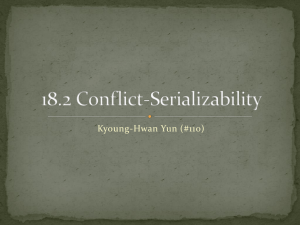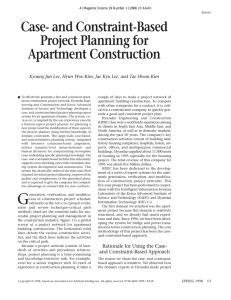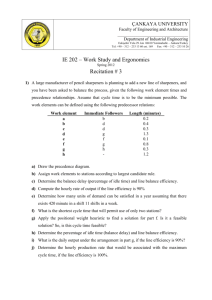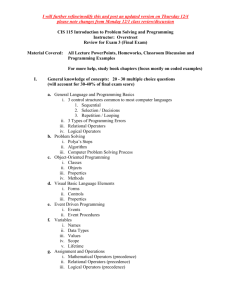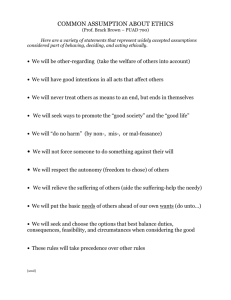Case and Constraint-Based Apartment Construction ... FASTrak-APT Jun n Kim***, Chang
advertisement
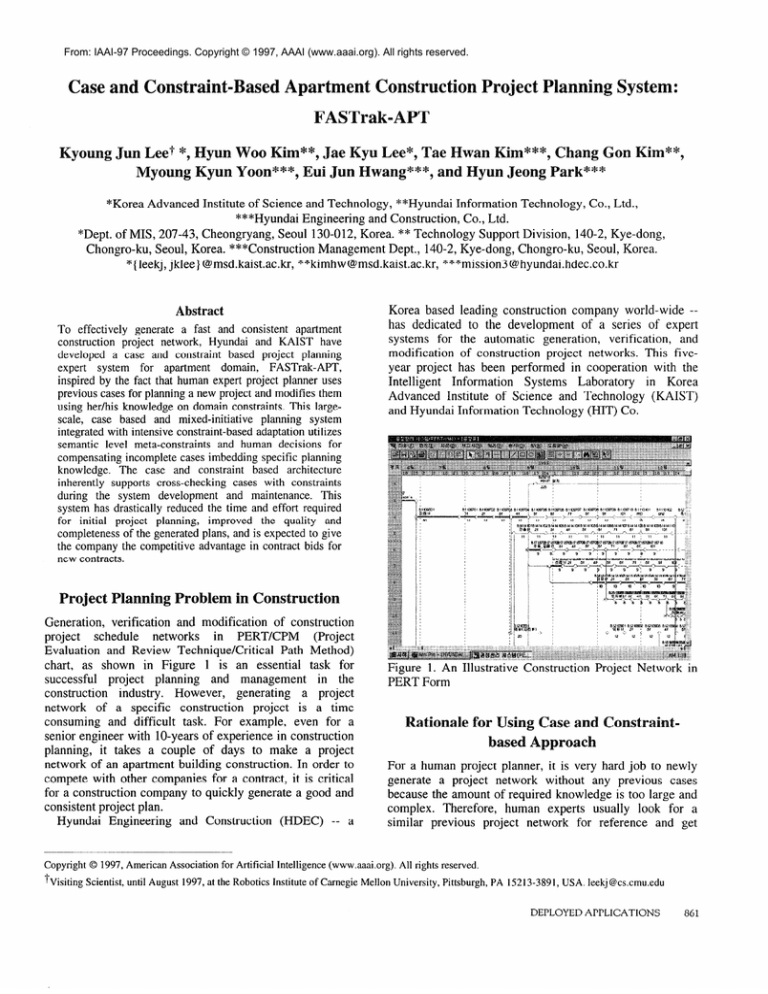
From: IAAI-97 Proceedings. Copyright © 1997, AAAI (www.aaai.org). All rights reserved.
Case and Constraint-Based
Apartment
Construction Project Planning System:
FASTrak-APT
young
Jun Lee? *, Hyun woo Kim**, Jae
Myoung Kyun Yoon***:, Eui Ju
n Kim***, Chang
un Jeong Park**
*Korea Advanced
Institute of Science and Technology, **Hyundai Information Technology, Co., Ltd.,
***Hyundai Engineering and Construction, Co., Ltd.
*Dept. of MIS, 207-43, Cheongryang, Seoul 130-012, Korea. ** Technology Support Division, 140-2, Kye-dong,
Chongro-ku, Seoul, Korea. ***Construction Management Dept., 140-2, Kye-dong, Chongro-ku, Seoul, Korea.
*{ leekj, jklee} @msd.kaist.ac’.kr, **kimhw@msd.kaist.ac.kr,
***mission3@hyundai.hdec.co.kr
Abstract
To effectively generate a fast and consistent apartment
construction project network, Hyundai and KAIST have
developed a case and constraint based project planning
expert system for apartment
domain,
FASTrak-APT,
inspired by the fact that human expert project planner uses
previous cases for planning a new project and modifies them
using her/his knowledge on domain constraints. This largescale, case based and mixed-initiative
planning system
integrated with intensive constraint-based adaptation utilizes
semantic level meta-constraints
and human decisions for
compensating incomplete cases imbedding specific planning
knowledge. The case and constraint based architecture
inherently supports cross-checking
cases with constraints
during the system development
and maintenance.
This
system has drastically reduced the time and effort required
for initial project planning, improved the quality and
completeness of the generated plans, and is expected to give
the company the competitive advantage in contract bids for
new contracts.
Korea based leading construction company world-wide -has dedicated to the development
of a series of expert
systems for the automatic generation,
verification,
and
modification of construction project networks. This fiveyear project has been performed in cooperation with the
Intelligent
Information
Systems Laboratory
in Korea
Advanced Institute of Science and Technology (KAIST)
and Hyundai Information Technology (HIT) Co.
Project Planning Problem in Construction
Generation, verification and modification of construction
project
schedule
networks
in PERT/CPM
(Project
Evaluation and Review Technique/Critical
Path Method)
chart, as shown in Figure 1 is an essential task for
successful
project planning
and management
in the
However,
generating
a project
construction
industry.
network of a specific construction
project is a time
consuming and difficult task. For example, even for a
senior engineer with lo-years of experience in construction
planning, it takes a couple of days to make a project
network of an apartment building construction. In order to
compete with other companies for a contract, it is critical
for a construction company to quickly generate a good and
consistent project plan.
Hyundai Engineering
and Construction
(HDEC) -- a
Copyright
0 1997, American
Association
for Artificial
Intelligence
(www.aaai.org).
Figure 1. An Illustrative
PERT Form
Construction
Project Network
in
Rationale for Using Case and Constrai
based Approach
For a human project planner, it is very hard job to newly
generate a project network without any previous cases
because the amount of required knowledge is too large and
complex. Therefore, human experts usually look for a
similar previous project network for reference and get
All rights reserved.
“fVisiting Scientist, until August 1997, at the Robotics Institute of Carnegie Mellon University,
Pittsburgh,
PA 15213-3891,
USA. leekj @cs.cmu.edu
DEPLOYED APPLICATIONS
861
by referencing
previous
human
expert’s knowledge
previous similar network. After finding the most similar
network, they modify it to be fitted for the current project
by using their own domain knowledge.
To simulate the expert’s behavior of using a past similar
case, the case based reasoning approach is adopted as a
fundamental
AI technique in this project. So far, most
studies in CBR are developed for toy problems except for
some systems (Aamodt and Plaza 1994), but this project is
a full scale study applicable for the real world situation and
deals with very large cases, each of which usually consists
of hundreds of activities and hundreds of precedence
In addition, as Shrobe pointed out in the
relationships.
excellent review of past IAAI Conferences (Shrobe 1996),
there has been a significant gap between practical uses of
case-based reasoning, which are limited almost totally to
case retrieval, and the full paradigm as it emerged in the
which involves not just retrieval but
research community,
also case adaptation, debugging, and so on. However, our
and maintenance
system deals with case adaptation
intensively as well as case retrieval in large-scale real
world context.
A new case usually has some discrepancies with the past
cases. So a retrieved case has to be modified to fill the gap
between them. In construction domain, the modification
implies the addition and deletion of some activities and
their associated precedence relationships.
For instance,
suppose the past case is a 20-floor building while the new
one is for l&floor building. Then we have to delete the
activities for the 19th and 20th floors. After deletion, the
succeeding activities should be pulled forward, unless any
constraint is violated. In order to effectively modify the
previous network to be suitable for the new construction
project, we adopt a constraint-based
case adaptation
approach.
For our first attempt, in 1995, the construction
of
apartment complex was selected as the first application
field because the planning task for apartments is relatively
simple and can effectively
employ the Case Based
Reasoning (CBR) with the constraint based verification and
modification. We named the apartment construction project
planning system as FASTrak-APT.
Integration of the case-based approach and constraintbased approach has the following two advantages. First,
construction domain constraints acquired from field experts
compensates incomplete cases imbedding specific planning
the system’s performance
knowledge
and improves
consequently.
Secondly, during the system development,
cross-checking of cases with constraints has improved the
quality of both of them. Through the cross-checking
process, the system developers could refine the previous
cases
to the
high-quality
referential
cases,
and
simultaneously validate and verify the domain constraints.
Previous Approaches
In the area of project management, there has been a lot of
research and development on project scheduling methods
862
INNOVATIVE APPLICATIONS
and management
techniques
assuming
that a project
network is given to the project manager (Bent and
Thumann
1994). However, since the earliest research
prototype CONSTRUCTION
PLANEX (Hendrickson et al.
1987) there has only been a limited amount of research to
automate or support the generation of progress networks
Artificial
Intelligence
or
knowledge-based
using
techniques, such as GHOST (Navinchandra,
Sriram, and
Logcher 1988), SIPE-2 (Kartam, Levitt, and Wilkins 1991)
and HISCHED (Ory and Abraham 1995). To run these
systems, users have some burden of inputting
much
information about activities, because these systems are not
designed to utilize past cases. OARPLAN (Winstaniey,
Chacon, and Levitt 1993), a model based planning system,
utilizes past cases, but its user has to input the precedence
relationships
between
activities.
In contrast to these
systems, the system that we have developed in this project
doesn’t require the users to input any precedence constraints
because the system utilize past cases containing precedence
constraints.
Zhang and Maher used a case-based reasoning method
for the structural design of buildings (Zhang and Maher
1995). They claim that CBR as a design model is appealing
intuitively
because much of design knowledge
comes
through the experience
of multiple,
individual
design
situations. This also holds true in construction planning
situation. For many domains where construction planning
knowledge is difficult to acquire and may not be objectively
applicable, the case-based paradigm can provide a model
for the acquisition
and reuse of specific
planning
knowledge because previous cases contain much valuable
knowledge in themselves.
It is the first time for Hyundai people to adopt an AI
technique to project planning. Previously human planners
have created the project plan without any automated aid.
They have not had structured case base accumulating past
project cases either. Some other companies have tried
database oriented approach, but it is not effective because it
requires much knowledge and effort to modify a project
network.
For these reasons,
Hyundai
and KAIST
considered using AI techniques: case-based technique for
reusing and accumulating good cases and constraint-based
technique for adapting a past case according to the
construction knowledge.
Application Description
Figure. 2 shows the architecture of FASTrak-APT.
The
system supports a mixed-initiative
planning procedure
(Veloso 1996). A user can interact with the system by
inputting the design specification, accumulating good cases
into the case base, selecting
constraints
among the
relaxation candidates, and informing the system of his/her
intentions or management strategies contingent to project
situation.
finish-date
: 1996/06/2 1
household
: (36 34)
construction-method
: PC-framing ) ................... .
H
The kernel system uses the project case base, case
management
knowledge base, database for WBS (Work
Breakdown Structure) and resources, and constraint base
containing knowledge about activity existence, precedence
relationship between activities, and subnetwork connection.
We explain the main procedures of the kernel system one
by one.
r
Case Filtering, Selection, Retrieval, and
Management
!k
trategy)
I
FASTrak-APT
Kernel
rrgure 2. Architecture of FASTrak-APT
Procedure of its Kernel System
and the Main
Knowledge Representation
We use frame-based representation scheme for representing
design specification,
cases, and constraints.
A design
specification of an apartment is illustrated as follows.
{ {Hukseok_Hyundai_Apt_Project
: Project
is-a
: Hukseok Hyundai Apt
name
address
: Hukseok, Seoul
: 1995/05/o 1
start-date
due-date
: 1996/06/2 1
: Flatland
ground-type
topography
: (clay 40 %) (fragile-rock 60 %)
(soft-rock 0 %) (solid-rock 0 %)
number-of-building
:1
: 5707
area
: 571
construction-area
: (36 68)
household
11
{ { Hukseok_Hyundai_Apt_l
: APT
is-a
part-of
: Hukseok_Hyundai_Apt_Project
: Corridor
apt-type
:1
base-last
ground-last
: 10
:1
pent-last
:2
phases
start-date
: 1995/05/o 1
When the user inputs the design specification of the current
project, FASTrak-APT selects the most similar case using a
two-step procedure. The first one is case filtering. Since
every case in case base cannot always be adapted for the
current project, we should filter out cases which, if adopted,
could lead to adaptation failure. We have the case filtering
knowledge in the case management knowledge base. The
filtering knowledge has been accumulated
through the
experience of adaptation failure during system development
and testing. For example, the variable phases is the one of
the variables used for the filtering process. The filtering
module filters out the cases which have different phases
value with that of the current case, because the variable
determines
the grouping
of concurrent
activities
and
therefore significantly
affects the topological
shape of
project networks. After the filtering process, we select the
most similar case among the remaining candidates using the
similarity measure. For the effective retrieval of suitable
cases, we extracted six important properties from domain
experts, as follows, and use the weighted sum of the
distance functions of the variables.
CW.
* I
Similarity = &y
i
. .
1 1
W, = Weight of each variable,
X, = Difference in number of floors,
X, = Difference in employed construction method,
X, = Difference in number household,
X, = Difference in building space,
X,= Difference in ground type, and
X, = Difference in topography of buildings.
After the selection and retrieval, the system renames the
activities and their precedence relations of the retrieved
case using a naming rule which gives the unique codes to
entities.
Activity Generation and Deletion
The retrieved case usually needs some activities to be
added or has some activities to be deleted, so the next step
is activity generation and deletion. There are two types of
activity generation and/or deletion in our system. The first
is caused by the difference of the number of floors (of
DEPLOYED APPLICATIONS
863
ground or basement) between the selected case and a new
project. For instance, if the selected case is a 20-floor
apartment while the new project is an 18floor building,
then the activities for the 19th and 20th floor should be
deleted.
The other is caused by the difference between employed
construction methods. For example, if the selected case
used reinforced concrete framing method, while the new
project will use the pre-enforced concrete framing method,
RC framing (bl1097) activities should be deleted and PC
framing (bl1099)
activities should be generated. The
following object represents this constraint.
{ {Construction-Method-Constraint1
: construction-method-constraint
is-a
method-type
: framing
: PC-framing
value
: b11099
use
: b11097
delete
>]
Precedence
Relationship
Generation
and Deletion
When the activities are generated or deleted, the precedence
relations
associated
with them should be created or
removed. We integrate the two kinds of methods for
the
precedence
relations:
and
deleting
generating
constraint-based approach and principle-based
approach.
Constraint-based
method uses precedence
constraints
acquired from domain experts. If the newly generated
activity has an associated precedence constraint, it can be
converted to a new precedence relationship satisfying itself.
In addition,
when planning
multi-apartment
building
construction,
we need to connect the network of each
connection
building.
To do this, we use subnetwork
constraints
which
define
the inter-building
activity
precedence relationship.
The principle-based
method uses general
network
principles for maintaining
project networks. Bell’s work
(Bell 1989) can be classified into this. We maintain the
soundness of a project network by keeping the following
basic principles.
1. There should be no cycle in the network.
2. There should be no isolated activity.
3. There should be only one start node and only one end
node.
For example, in the case of 18-floor building case, if an
18th floor activity succeeded by an activity is deleted, the
17th floor activity of the same kind as the 18th should be
succeeded by the activity. As such, this approach is not
based on knowledge but based on logical rationale.
Constraint
Constraints
network as
relationships.
checking is
time, latest
864
Satisfaction
Checking
are used for verifying the current project
well as for generating relevant activities and
The first step in constraint
satisfaction
calculating the earliest start time, earliest finish
start time, latest finish time of all activities
INNOVATIVE APPLICATIONS
using CPM (Critical Path Method). With these values, we
check the satisfaction of the constraints. We have acquired
approximately
430 domain
constraints
about activity
existence, activity precedence relationship, and subnetwork
For the convenient
representation
and
connection
maintenance of the large number of constraints, we should
represent them in semantic level. On the other hand, for the
reasoning efficiency of the system, we should tightly couple
the constraints into the activities. To satisfy the two criteria,
i.e. user convenience
and reasoning
efficiency,
we
developed a meta-constraint representation method where a
semantic level constraint for users is converted to a couple
of instantiated constraints.
In addition, most constraints should be able to have
different parameter values contingent to the situation. For
example, when we construct a lo-floor apartment, the first
floor’s plastering activity starts after starting the 3rd floor’s
framing
activity.
However,
in the case of 15-floor
apartment, the first floor’s plastering activity should start
after starting the 4th floor’s framing activity. To support the
contingency,
we connect forward-chaining
rules with the
The forward
chaining
inference
is
meta-constraint.
supported by the tool UNIK-FWD (Lee et al. 1994). Figure
3, 4, and 5 show an illustrative constraint and its associated
rules for the above example, instantiation
process using
forward chaining inference, and the instantiated precedence
constraint respectively.
{ { Precedence-Constraint-3-b
: precedence-constraint
is-a
: FS ; Finish-to-Start
relationship-type
relationship-operator
: >=
relationship-value
:o
: day
value-type
: framing
predecessor-wbs
: <contingent-valuel>
predecessor-floor
rule-groups : (<contingent-value-l>
Precedence-Constraint-3-b-rule-group)
successor-wbs
: plastering
successor-floor
: <base-first>
importance
: 0.7
(fwd-RULE Precedence-Constraint-3-b1
[RULE-GROUP Precedence-Constraint-3-b-rule-group]
*current-apt <apt>)
(precedence-constraint-control
(apt *frame-name (= <> <apt>) “ground-last (<= <> 12 ))
--> (new-value ‘precedence-constraint-control
‘contingent-value- 1 3))
(fwd-RULE Precedence-Constraint-3-b-2
[RULE-GROUP Precedence-Constraint-3-b-rule-group]
(precedence-constraint-control
*current-apt <apt>)
(apt *frame-name (= <> <apt>) “ground-last (>= <> 13 ))
--> (new-value ‘precedence-constraint-control
‘contingent-value- 1 4))
Figure 3. An Example of Precedence Meta-constraint
ant
its Forward Chaining Rules
IMeta Constraint
I
* Plastering[BASE_FIRST]
Framing[K]
I
I
FS >= 0
IF <GROUND_LAST>
K= 4
>= 13
de4
Framing[4*
c d c c m*Plastering[l]
FS >= 0
Figure 4. An Illustrative
{ {PC3-B-P2B 1-O
is-a
value-type
relationship-value
relationship-operator
relationship-type
predecessor
successor
importance
11
Figure 5. An Instantiated
Instantiation
of Meta Constraint
: precedence-constraint-instance
: day
:o
: >=
: FS
: Hukseok_Apt_l-Framing-04
: Hukseok_Apt_l-Plastering-01
: 0.7
Precedence Constraint
ecisisn on Satisfaction and Relaxation
We check the project network with the instantiated
constraints. If a violated constraint is found, we should
decide whether it will be satisfied or relaxed. There are two
ways for the decision: automatic and manual. For automatic
selection of the constraints to be relaxed, each constraint
has an importance value. Constraints
with the higher
importance value should be satisfied preferentially.
The
other way is user selection. If the system shows the violated
constraints, then user can select some of them to be relaxed.
For example, the button ‘Add All’ of figure 6 can be used
when a user wants to satisfy all of the violated constraints.
If the user wants to relax some constraints, she or he click
the ‘Delete’ button after selecting them in the lower box.
Figure 6. The Window for Selecting Violated Constraints
Activity and Precedence Modification
The modification
occurs from the effort satisfying
a
violated constraint or satisfying user’s intention. To satisfy
a violated precedence constraint, we convert the constraint
to a precedence relationship. Since adding a precedence
relationship
into the network can increase the project
makespan, it is important to keep the makespan stabilized
and
simultaneously
satisfy
important
precedence
constraints.
We use three methods for reducing
the
makespan. First, we can delete relatively unimportant
precedence
relationships.
The precedence
relationships
which are not defined in the precedence constraint base are
good candidates to be deleted. Of course, deletion of a
precedence relationship should be confirmed by the user.
Secondly, we can reduce the value of the precedence
relationship as far as satisfying its associated precedence
constraint. Finally, we can reduce the duration of activities
in the critical path. To keep from unreasonable
duration
reduction, the system uses the WBS database and considers
the status of the resource utilization.
ancement of Solutious
The plans generated by FASTrak-APT have been proved by
human experts to be technically sound, and even satisfied
more constraints
than the cases prepared by domain
experts. Therefore, the results were used for enhancing case
base, and the refined case base helped improve the quality
of generated
plans. The cross-checking
and mutual
enhancement
is one of important
benefits
from the
integration of case-based approach and constraint-based
approach. One of remained issues we are working on for
user satisfaction is flexible visualization of plans to support
the demand on various levels of views from the different
levels of users in organization.
ge Acquisition, ~m~~ementati~u an
aintenance
Before entering the knowledge
acquisition
phase, we
standardized and constructed three-leveled
WBS (Work
Breakdown Structure) database, which contains a lot of
information
such as average
duration,
hierarchical
structure, location, and seasonal factor of each activity etc.
Ten domain experts participated in the task. After that, we
made a cross-table between all WBS activities and let a 9year-experienced
expert mark in the cell if the two
activities have any technical precedence relationships. The
result were checked and refined by other five experts. The
collected technical precedence constraints could not be
complete because there can be some managerial
and
conventional precedence relationships. However, we could
observe that the lack of information is compensated by case
base.
FASTrak-APT
has been implemented on Windows 95
using Visual C++ and UNIK (Lee et al. 1994), an expert
DEPLOYED APPLICATIONS
865
system tool developed by KAIST and IntelliNet Co. Since
KAIST has the right to use and enhance the source codes of
UNIK under the cooperation with IntelliNet Co., it is a
good choice to use it for developing flexible and
expandable systems. Currently, FASTrak-APT has about
430 meta-constraints that can create thousands of
instantiated constraints (e.g. approximately 2000 ones for a
20-floor building). So far, we have accumulated 50 highquality cases prepared and verified by human experts. The
project team consists of one project manager, two research
programmers, two application programmers, and three
domain experts. The roles of each group are described in
Table 1. Hyundai and KAIST have been extending this
system for bridge construction and power transmission
tower construction planning since September 1996.
1 Methodology Consulting
Overall Manaeement & Control
2 Knowledge Engineering
Case Base Design
Kernel System Development
R&D on Bridge Case
Application
2 GUI Development
Interface to Project Management S/W
Programmers
System Verification and Maintenance
(HIT/HDEC)
R&D on Power Transmission Tower
Domain
3 Requirement and Specification
Knowledge Transfer and Verification
Experts
Case-base Construction
(HDEC)
i System Validation
1 Knowledge Maintenance
Table 1. Roles of Members in Each Group
Project
Manager
Research
Programmers
(KAIST/HIT)
I
Development Cost
analysis will give the company the competitive advantage
over other companies in contract bids for new contracts.
The accumulated good cases and the digitalized and refined
knowledge became an invaluable asset for the company. In
addition, the company now uses the system in training
employees for construction management.
Acknowledgments
This research is funded by Hyundai Engineering. &
Construction Co., Ltd. and Hyundai Information
Technology Co., Ltd. in Korea. We are particularly grateful
to Executive Directors Jae Ho Yoon and Seok Boo Choi for
their strong support and helpful advice.
References
Aamodt, A. and Plaza, E. 1994. Case-based Reasoning:
Foundational Issues, Methodological Variations, and
System Approaches, AZ Communications, 7( 1):39-59.
Bell, C. 1989. Maintaining Project Networks in Automated
Artificial Intelligence Planning, Management Science,
35(l): 1192-1214.
Bent, J. and Thumann, A. 1994. Project Management for
Engineering and Construction (2nd edition), Fairmont
Press.
Hendrickson, C., Zozaya-Gorostiza, C., Rehak, D.,
Baracco-Miller, E., and Lim, P. 1987. An Expert System
for Construction Planning, Journal of Computing in Civil
Engineering, 1(4):253-269.
Kartam, N., Levitt, R., and Wilkins, D. 1991. Extending
Artificial Intelligence Techniques for Hierarchical
Planning, Journal of Computing in Civil Engineering,
5(4):464-477.
The development costs of FASTrak-APT for the two years
were calculated at approximately $42,000 for the hardware,
$162,000 for the outsourcing, and $417,000 for the internal
manpower. So, the total cost was about $621,000.
Lee, J. K. et al. 1994. UNZK User’s Manual (in Korean),
Intelligent Information Systems Laboratory, Korea
Advanced Institute of Science and Technology.
Navinchandra, D., Sriram, D., and Logcher, R. 1988.
GHOST: Project Network Generator, Journal of Computing
Application Use and Estimate of Payoff
Ory S. and Abraham W. 1995. Knowledge Based System
for Construction Planning of High-rise Buildings,Journal
in Civil Engineering., 2(3), 239-254.
FASTrak-APT has been used by the Construction
Management Department since September 1996 and is now
ready to be used for the construction sites. FASTrak-APT
has been proved to reduce the effort required to generate an
initial project plan from 7 man-days to 1 man-day. The cost
of updating a plan, which occurs every three months per
project, has been also reduced from 2 man-days to 0.5 man
-day. The company expects to be able to reduce the effort
to complete bid document from 10 man-day to 1 man-day if
the system is enhanced to support aggregating resource
utilization and the cost of activities calculation. The
expected annual benefit using the above parameters is about
$616,000. Using the FASTrak-APT relieved the company
of the suffers from the deficiency of project management
experts. In addition, the faster simulation and feasibility
866
INNOVATIVE
APPLICATIONS
of Construction
121(2):172-182.
Engineering and
Management.,
Shrobe, H. 1996. The Innovative Applications of Artificial
Intelligence Conference: Past and Future, AZ Magazine,
17(3): 15-20.
Veloso, M. 1996. Towards Mixed-Initiative RationaleSupported Planning. In A. Tate (Ed.), Advanced Planning
Technology. Menlo Park, CA: AAAI Press.
Winstaniey, G., Chacon, M., and Levitt, R. 1993. ModelBased Planning: Scaled-up Construction Application,
Journal of Computing in Civil Engineering., 7(2):199-217.
Zhang, D. and Maher, M. 1995. Case-based Reasoning for
the Structural Design of Buildings, Proceedings of ZEALAZE
(Industrial and Engineering Applications of Artificial
Intelligence and Expert Systems) 95, 14 1 - 150.
